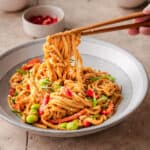Sesame Noodles
Servings: 4
Calories: 369kcal
Ingredients
- 1 bunch scallions, top 1 inch trimmed and sliced on a bias
- 20 ounces (570g) fresh udon noodles (see Note 1 for substitutes)
Sesame Sauce
- 2 teaspoons freshly grated ginger
- 3 cloves garlic, grated or crushed with a press
- 3 to 3 ½ tablespoons (40 to 50g) Chinese roasted sesame paste (see note 2)
- 2 tablespoons Chinese light soy sauce (see note 3)
- ½ tablespoon dark soy sauce (optional; see note 4)
- ½ tablespoon agave nectar or organic cane sugar
- ½ tablespoon Chinese black vinegar (see note 5)
- 1 tablespoon toasted sesame oil
- 1 heaping tablespoon chili-garlic sauce or sambal oelek (see note 6)
Protein
- 6 ounces (170g) shelled edamame (omit for a side dish; see note 7)
- Kosher salt as needed
Fresh Vegetable (pick one)
- 1 medium red/orange bell pepper, thinly sliced
- A few handfuls of shredded napa or savoy cabbage
- A few handfuls of finely diced English cucumber
Finishing
- ¼ cup (35g) roasted peanuts, chopped (omit for nut-free)
- 2 tablespoons roasted white or black sesame seeds
- Chinese chili crisp or chili oil (optional)
- Fresh chili peppers, sliced (optional, for spicy!)
- A drizzle of toasted sesame oil (optional)
Instructions
- Bring a large saucepan of water to a boil for the noodles.
- While the water is coming to a boil, add the sliced scallions to a bowl of cold water. Soak for 10 minutes, or while you prep the other ingredients (this helps mellow their pungency but you can skip it if you don’t mind that). Scoop out scallions with a slotted spoon and dry off with a towel.
- Make the sesame sauce. Stir together the ginger, garlic, sesame paste, both types of soy sauce, agave, Chinese black vinegar, toasted sesame oil, and chili-garlic sauce. Whisk well to combine, breaking up any clumps from the sesame paste.a. Taste, adding more agave or sesame paste as needed to balance the acidity as needed, or more chili sauce for more heat. The sauce will taste very concentrated right now but it’s going to coat a lot of noodles and mix-ins.
- Cook the noodles according to the package instructions. Before draining, scoop out some of the noodle cooking water and set aside.a. Drain and rinse the noodles under cold water until the noodles are cool. Return the noodles to the saucepan or a large serving bowl.b. If making the noodles ahead of time, toss them with a bit of sesame oil to prevent sticking.
- If using edamame, add it to a bowl and season with a few pinches of salt.
- In a large bowl, combine the sesame sauce and cooled noodles and toss to coat with tongs. If you are not using fresh udon noodles, add a bit of the reserved noodle water. This makes it easier for the sesame paste to cling to the noodles and prevents them from drying out. I use about 2 tablespoons of water to start.
- Add the drained scallions, vegetable of choice and seasoned edamame if using, sesame seeds, and peanuts. Toss again to combine.
- If desired, spoon a little Chinese chili crisp on top before serving. When serving leftovers, add a dash of vinegar or spoon of chili sauce, as desired to freshen up the flavors.
Notes
- I personally love using fresh udon noodles in this recipe because of their bouncy slurpable texture. They are much lighter than other noodles, so if you are using other fresh noodles, like fresh white Chinese noodles, use just 10 to 12 ounces (280 to 340g); use the lower amount for saucier noodles. If using dried noodles, use just 8 ounces (225g).
- If you can’t get Chinese sesame paste, use a mixture of creamy, unsweetened peanut butter and tahini.
- You can substitute with regular supermarket soy sauce or tamari. You might need to add a couple dashes more of the latter, as Chinese light soy sauce is a bit saltier.
- If you don’t have dark soy sauce, use more of the regular/light soy sauce.
- Don’t have Chinese black vinegar? You can sub with rice vinegar (or Shaoxing wine, if you have it), but you’ll likely want to add a bit more (1 tablespoon total). If gluten-free, use rice vinegar, as Chinese black vinegar contains gluten.
- This amount of chili sauce adds a moderate amount of heat. Feel free to use more for a spicy version, or less for a mild version.
- The edamame helps make this a main meal, but feel free to omit if serving as a side dish. If you want to stretch it to 4 heartier servings, use 12 ounces of edamame. If using frozen edamame, you can simply defrost it in warm water, or follow the package instructions (e.g., boil it for 2 minutes).
